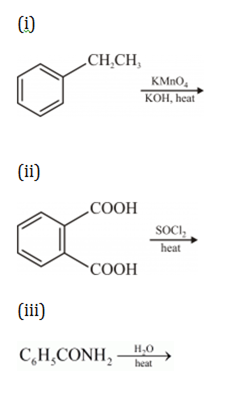 Long Answer Type
Long Answer Type(a) Define the terms osmosis and osmotic pressure. Is the osmotic pressure of a solution a colligative property? Explain.
(b) Calculate the boiling point of a solution prepared by adding 15.00 g of NaCl to 250.0 g of water. (Kb for water = 0.512 K kg mol-1), (Molar mass of NaCl = 58.44 g)
(i) NF3 is an exothermic compound whereas NCl3 is not.
(ii) F2 is most reactive of all the four common halogens.
(b) Complete the following chemical equations:
(i) C + H2SO4 (conc.)-->
(ii) P4 + NaOH + H2O-->
(iii) Cl2+F2 ------>
(excess)
(a) Account for the following:
(i) The acidic strength decreases in the order HCl > H2S > PH3
(ii) Tendency to form pentahalides decreases down the group in group 15 of the periodic table.
(b) Complete the following chemical equations:
(i) P4 + SO2Cl2-->
(ii) XeF2 + H2O--->
(iii) I2+HNO3(conc.)--->
Answer the following:
(i) Haloalkanes easily dissolve in organic solvents, why?
(ii) What is known as a racemic mixture? Give an example.
(iii) Of the two Bromo derivatives, C6H5CH(CH3)Br and C6H5CH(C6H5)Br, which one is more reactive in Sn1 substitution reaction and why?
Describe the following giving one example for each:
(i) Detergents
(ii) Food preservatives
(iii) Antacids
(i) Detergents: Synthetic detergent is a cleansing substance that acts similarly to soap but is made from chemical compounds rather than fats and lye. These detergents were developed in order to replace soaps for cleaning, to overcome some of soap's shortcomings. These can be used both in hard and soft water. Example: Sodium p-dodecylbenzenesulphonate
Synthetic detergents can be classified as:
Anionic: Having negatively charged head and widely used due to cost and performance. Uses include:
(i)Laundry detergents
(ii)Dishwashing liquids
(iii)Oven cleaners
Cationic: Having a positively charged head. Uses include:
(i) Cleaning plastics
(ii)Hair shampoos
(iii)Fabric softeners and conditioners
Non-ionic or neutral: Having an uncharged head. Uses include:
(i)Car shampoos
(ii)Dishwasher detergents
(iii)Cosmetics
(ii) Food Preservatives: These are the chemical substances which are added to the food materials to prevent their spoilage and to retain their nutritive value for long periods. Example: Vinegar, salt, sugar, vegetable oil, sodium benzoate (C6H3COONa), and salts of propanoic acid.
Food preservation involves preventing the growth of bacteria, fungi (such as yeasts), or other micro-organisms as well as retarding the oxidation of fats that cause rancidity.
(iii) Antacids: Any drug that is used to counteract the effects of excess acid in the stomach and raise the pH to an appropriate level is called an antacid. Such as sodium bicarbonate, that neutralizes acid
Give chemical tests to distinguish between
(i) Propanal and propanone,
(ii) Benzaldehyde and acetophenone.
(b) How would you obtain
(i) But-2-enal from ethanal,
(ii) Butanoic acid from butanol,
(iii) Benzoic acid from ethylbenzene?
(a) Describe the following giving linked chemical equations:
(i) Cannizzaro reaction
(ii) Decarboxylation
(b) Complete the following chemical equations:

